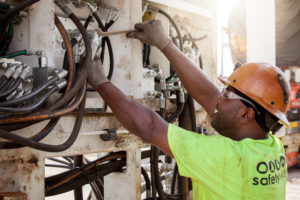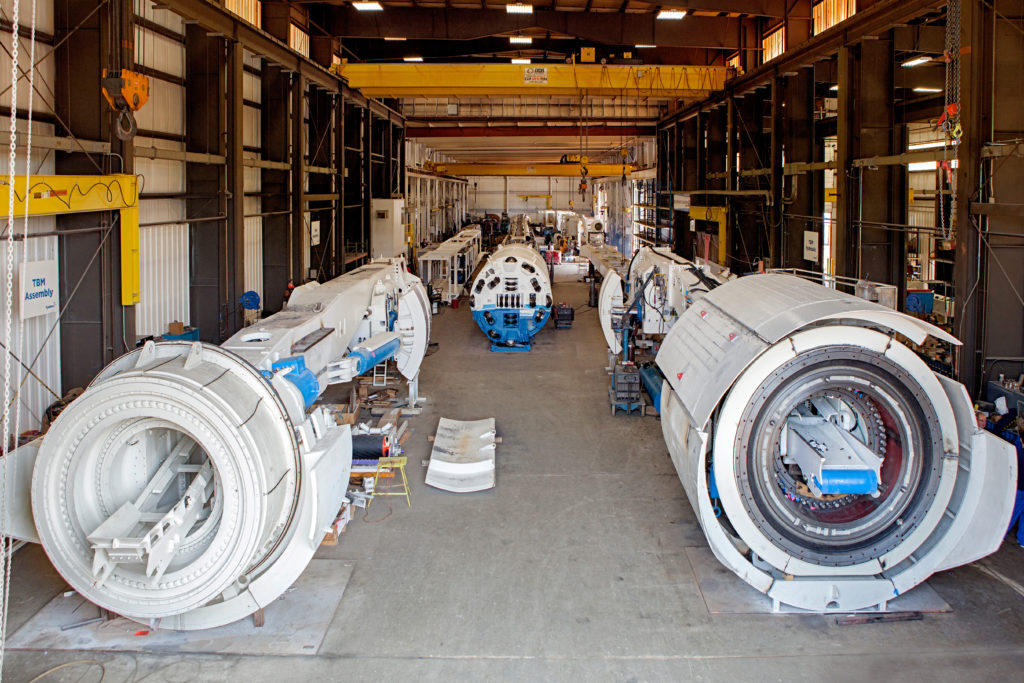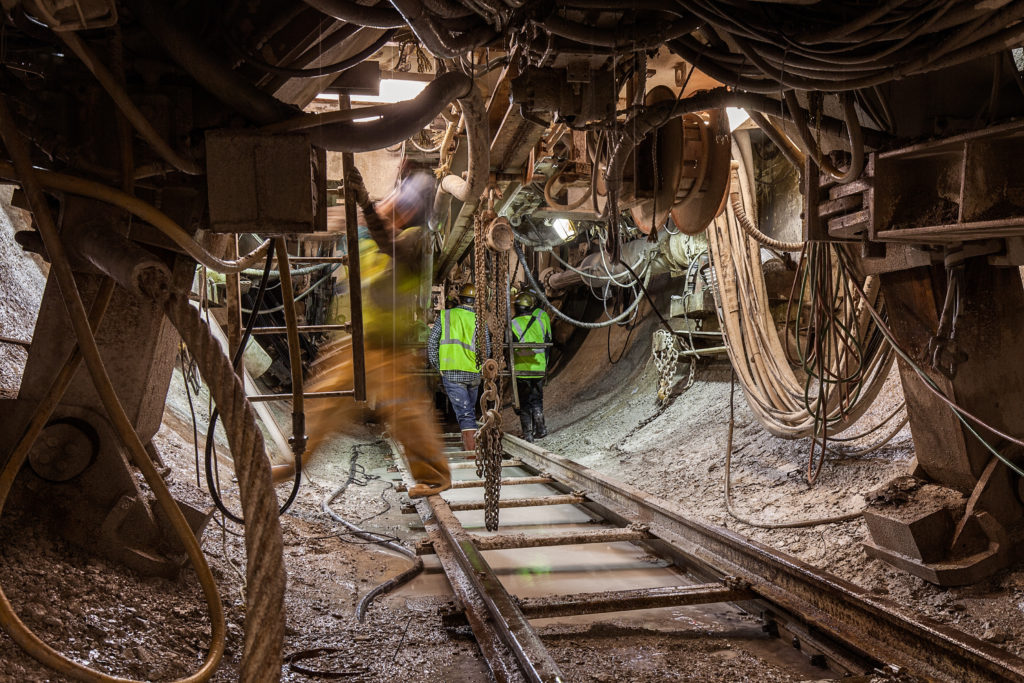Year: 2017
STUVA 2017
Event Name: STUVA Expo and Conference
Dates: December 6-7, 2017
Location: Messe Stuttgart, Germany
Venue: Messe Stuttgart Trade Fair Centre
With an increasing rate of growth, STUVA-Expo will take place parallel to STUVA-Conference December 6-7 in Messe Stuttgart, Germany. The Robbins Company is looking forward to sharing information about current TBM projects operating world-wide at this ever-growing event.
EPB Excavation of Less Than Five Meters Below the Historic Structure of Chandpole Gate on the Jaipur Metro Project
The tunnels excavated by Continental Engineering Corporation (CEC) for the underground section of the Jaipur Metro project faced the usual challenges posed by metro projects worldwide, including small site footprints, and the associated problems regarding segment and muck storage space, etc. These challenges were, however, relatively straightforward when compared to the challenges faced by the tunneling operations. The Earth Pressure Balance (EPB) TBMs were required to bore under extremely low overburden, alongside and beneath several culturally sensitive historic structures. The age of these structures and their construction methods/materials were of great concern when considering the possible consequences of tunneling-induced ground settlement and vibrations. This paper will describe the measures taken regarding TBM operations and surface monitoring to ensure that these historic structures suffered no adverse effects due to tunneling.
Difficult Ground Solutions (DGS): New TBM Solutions carve a Path to Success
In many TBM-driven tunnels, the occurrence of squeezing ground, high inrushes of water, blocky rock, and other challenges is a real possibility. Difficult Ground Solutions (DGS) reduces risk to contractors and owners in these conditions while providing accurate ground investigation. The story of how these methods came into practice involves hardship that tested the mettle of a shielded hard rock TBM on a recent project. What came out of those challenges is a new way to deal with both predicted and unforeseen ground conditions in rock and mixed ground. DGS features such as dual-range cutterhead drives, high pressure grout injection systems for face stabilization, and water inrush control are customizable and should be considered to be built into shielded TBMs. This paper will cover solutions informed by field experiences, the tools it takes to be successful in difficult ground, and how they are applied.
The Return of TBMs to Norway at Røssåga HEPP—TBM Operation Through Extremely Hard Rock, Unstable Rock Mass, and Other Challenges
The TBM that broke though at Røssåga HEPP in December 2015 was the first to breakthrough in Norway in more than 20 years. During the excavation the TBM encountered extremely hard rock (over 280 MPa), which posed an extreme challenge for both the TBM and the cutters. During the excavation a highly efficient main bearing replacement was also performed in the tunnel. This paper discusses the project as a whole, including TBM design, Onsite First Time Assembly (OFTA) of the machine, challenges faced, and project outcomes.
Rebuilt, Refurbished, Remanufactured: Designing a TBM to Live for Generations
 With the increase in large TBM projects over the last few decades and a global awareness of their environmental impacts, there has been a greater focus on the origin of TBMs and their parts. The focus has been further highlighted by the ITAtech; a technology-focused committee for the International Tunneling Association (ITA-AITES) that produced guidelines on rebuilds of machinery for mechanized tunnel excavation were released in 2015. While the guidelines are relatively new, Robbins has a long history of delivering robust machines, many of which are rebuilt (many are also 100% new). In this post, I’d like to explore just what a “rebuilt” TBM is, and what that means to Robbins as a TBM manufacturer.
With the increase in large TBM projects over the last few decades and a global awareness of their environmental impacts, there has been a greater focus on the origin of TBMs and their parts. The focus has been further highlighted by the ITAtech; a technology-focused committee for the International Tunneling Association (ITA-AITES) that produced guidelines on rebuilds of machinery for mechanized tunnel excavation were released in 2015. While the guidelines are relatively new, Robbins has a long history of delivering robust machines, many of which are rebuilt (many are also 100% new). In this post, I’d like to explore just what a “rebuilt” TBM is, and what that means to Robbins as a TBM manufacturer.
History and Terminology
Throughout Robbins’ history (over 65 years), our TBMs and design philosophies have been based on the understanding that TBMs require a substantial initial investment, and designing machines for single tunnels is neither economical nor sustainable. This realization has resulted in robust, sturdy designs of high quality that–even before the pencil is put to paper–are meant to last for multiple projects. This is clearly shown when you look at the number of Robbins TBMs around the world that are excavating their second, third, fourth or even their eighth or ninth tunnel. There are even Robbins TBMs manufactured in the 1960s that are still in operation!
For Robbins, the term “rebuilt” describes any manner of creating a custom TBM from already existing components. It is the term we use most and continue to use. The ITAtech guidelines introduce different terminologies depending on the extent to which a TBM is rebuilt. They are, very shortly, described here:
- Remanufacturing – Remanufacturing is a process with the aim to start a new life cycle of the product using its current or modified configuration.
- Refurbishment– Refurbishment can be considered a full maintenance, where defect parts are replaced to extend the life of the product in its original configuration or with small modifications.
The guidelines describe the requirements of each process in order to designate a TBM “refurbished” or a “remanufactured”, but in reality the majority of “rebuilt” TBMs may be somewhere in between these qualifications.
The Robbins Philosophy
Over the years Robbins has built a quality assurance system that ensures when we deliver a rebuilt machine, either to the original configuration or a modified one, we still adhere to a design life of 10,000 hours. This standard also includes checks to make sure that all the components are in a functional condition of ‘as new’ or ‘new’. Due to our long experience in rebuilding TBMs, we can offer in principal the same warranty on a rebuilt machine as a new machine.
The Robbins philosophy on this is that, in order to offer the same design life and same warranties on a rebuilt machine, the initial design of the TBM will need to consider that the TBM will be used on several projects. This means that the major structures will need to be strong enough to survive even the toughest conditions and that worn parts can easily be replaced. If the machine is not properly designed for multiple projects, there will be a need to do major work to get the TBM in a working condition either in its original or modified configuration. Robbins strongly believes that considering the total life cycle of a machine, even in its first design stages, is the most economical and sustainable option.
One can argue that project owners typically only have one project and that the condition of the TBM and the suitability of its rebuild is therefore not essential. This is something that is also reflected in many of today’s tunneling projects, where the commercial consideration is often given far more attention than the technical one. We would argue, however, that an initially sturdy and robust design of the TBM will give the project more uptime, higher production rates and better flexibility if unexpected conditions are encountered, making it a good and effective kind of insurance for the project. This effect has been clearly identified in the field, where Robbins has more than 90% of world production records in hard rock.

What’s Missing
In terms of the international guidelines, they are certainly necessary and welcomed. However, the strictness of the guidelines makes them hard to adopt worldwide and perhaps not realistic for the majority of TBM rebuilds, which are customized based on project needs. The ITAtech guideline is also missing something else: the definition of what makes a TBM “new”. While opinions from different suppliers vary, Robbins is perfectly clear on this topic: If you are buying a new TBM, then it is a 100% new TBM with only 100% new components. We strongly believe the whole industry should commit to this definition of what makes a TBM “new”, and this definition should be added to the guidelines.
Robbins has throughout the years built up a vast experience in providing the right machine for the right project, whether that means a new or rebuilt machine. As a part of this experience, we are convinced that the life cycle of TBMs should be considered at the earliest stages of the design process. Designing machines with ease of rebuilding in mind ensures that we do not have to start from scratch every time a machine needs work. It also results in time, cost, and energy savings when the time does come to rebuild a machine for a new project. For the industry, this type of perspective is the only economical and sustainable option going forward.
By Sindre Log, Civil Engineer and General Manager for Robbins Norway
SBU-RC Spec Sheet
The SBU-RC is a game-changer for the trenchless industry, making long, line-and-grade-sensitive crossings possible at small diameter. The SBU-RC is an unmanned, articulated mixed ground and hard rock boring machine for use with standard Auger Boring Machines (ABMs) or pipe jacking systems.
Continuous Conveyor Spec Sheet
Robbins’ continuously advancing conveyors are designed to increase the efficiency of muck removal and vastly simplify tunneling logistics. Robbins Continuous Conveyors have been successfully employed on nearly 100 projects worldwide—more than any other TBM tunnel conveyor manufacturer.
Large-Diameter 20-Inch Disc Cutters: A Comparison of Tool Life and Performance on Hard Rock TBMs
Optimization of disc cutter life and penetration rate in hard rock can be one of the biggest predictors of project success. With hard rock TBMs being used today in ever more difficult conditions and longer tunnels, the question of which type of disc cutter to be used becomes critical. At one such project in Northeastern China, varying disc cutter tool steels and sizes were put to the test on a total of nine different 8.5m diameter hard rock, Main Beam TBMs from various manufacturers. The TBMs excavated sections of a vast water tunnel in similar granitic geology.
This paper will look at the development of 20-inch disc cutters and the case for large diameter cutters, using the most recent example in China as a focus area of study. Varying advance rates, cutter life, tool steels, and challenges excavating the rock will be discussed. The paper will conclude with recommendations for optimal cutter life in TBMs destined to bore long tunnels in hard rock.
Use of “Command Chair” Simulator Technology to Optimize Modern TBM Performance
TBM operator cabs and controls are often a long way down the list of priorities when it comes to the overall design of a Tunnel Boring Machine. However, their proper design and inclusion of the latest technology can mean the difference between a successful project and an unsuccessful one.
On soft ground machines the industry often puts operators in control of machines with little or no practical experience of that particular machine or the control systems. This practice can, in some cases, lead to major incidents such as ground heave or sinkholes in densely populated urban zones causing major disruption, downtime and untold damages and cost.
This paper will discuss the advances and developments in TBM operator controls and the use of “command chair” technology as both a training tool in the form of a boring machine simulator and as a way of controlling modern-day TBMs.
Rondout West Branch Bypass Tunnel—TBM Boring in Hard Rock Against High Water Pressure and High Water Inflows Beneath the Hudson River in New York
This paper focuses on a single shield hard rock tunnel boring machine that is set to bore in hard rock, high water inflows and high water pressure in New York State. To overcome the difficult conditions the TBM is designed to handle 2500 gpm water inflows and seal against 30 bar of pressure. The TBM will bore a tunnel to replace a damaged portion of the Delaware Aqueduct that supplies half the raw water to New York City. The 2.5 mile bypass tunnel passes beneath the Hudson River with geology consisting of shale and limestone.
Due to the high water pressure and inflows, the TBM was designed with new sealing systems for the main bearing and to close the TBM off if high water inflows are encountered. The TBM is to be equipped with two dewatering systems and multiple drilling and grouting systems for pre excavation grouting and segmental lining backfill. Systematic drilling and grouting procedures specific to the project were developed and incorporated into the TBM and backup design to ensure that the TBM can handle the extremely difficult ground conditions of the project.
Recent Posts
- Long Haul TBM: Use of a Rebuilt Main Beam Machine at the DigIndy Tunnel System in Indianapolis, IN
- Evaluating TBM Design and Performance, 30 Years Apart: The Lesotho Highlands Water Tunnel, Phase 1 and Phase 2
- Use of a Tunnel Boring Machine on Nepal’s First and Second TBM-Driven Tunnels
- Record-Setting Large Diameter Mixed Ground Tunneling in Turkey: The Eşme-Salihli Railway Tunnel
- Lessons Learned During Excavation of the Incredibly Challenging Yin Han Ji Wei Water Diversion Tunnel

 Close
Close  Menu
Menu 
